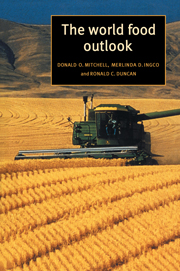Book contents
- Frontmatter
- Contents
- List of figures
- List of tables
- Preface
- List of abbreviations
- 1 The world food problem
- 2 The price of food
- 3 Gains in consumption levels
- 4 World food production increases
- 5 Population growth and food demand
- 6 The quantity and quality of the resource base
- 7 Raising yields
- 8 Changing consumption patterns
- 9 Simulating the future world food situation
- 10 The world can feed twice as many in twenty years
- 11 A robust prediction?
- 12 Africa presents a special challenge at the turn of the century
- Appendix The World Grains Model
- References
- Index
Preface
Published online by Cambridge University Press: 06 November 2009
- Frontmatter
- Contents
- List of figures
- List of tables
- Preface
- List of abbreviations
- 1 The world food problem
- 2 The price of food
- 3 Gains in consumption levels
- 4 World food production increases
- 5 Population growth and food demand
- 6 The quantity and quality of the resource base
- 7 Raising yields
- 8 Changing consumption patterns
- 9 Simulating the future world food situation
- 10 The world can feed twice as many in twenty years
- 11 A robust prediction?
- 12 Africa presents a special challenge at the turn of the century
- Appendix The World Grains Model
- References
- Index
Summary
Contrary to recent reports, there is no worldwide food crisis, and the fact that market prices are continuing to decline in real terms tells us that the people most closely involved, that is those who are putting their money into investing, producing, storing and consuming, obviously do not think that there will be a crisis in the future. To create a seeming crisis situation, we are regaled with figures of up to 1.3 billion people in absolute poverty, with warnings of an impending slowdown in agricultural production growth, and with threats of increasingly adverse environmental effects. We are not told very often that the bottom of the range of estimates of absolute poor is 300 million. Seventy per cent of the estimated absolute poor are supposed to be found in South and Southeast Asia. Yet reconciliation of these numbers with the fact that this part of the world has experienced the highest per capita income and the highest food production growth rates over the past decade or more is never attempted. In the face of ever-improving indicators of food production, incomes, health, infant mortality and population growth rates, and while all the forecasts of doom have proved wildly wrong in the past, we are warned that doom is still around the corner.
The world's population is still growing, more food will be needed, and agricultural productivity will have to continue to increase. These are problems to be solved while reducing the environmental impact of agriculture – which means developing more environmentally friendly farming practices. Public decisions about these matters should be made in the light of reason and good information, however.
- Type
- Chapter
- Information
- The World Food Outlook , pp. xv - xviPublisher: Cambridge University PressPrint publication year: 1997



